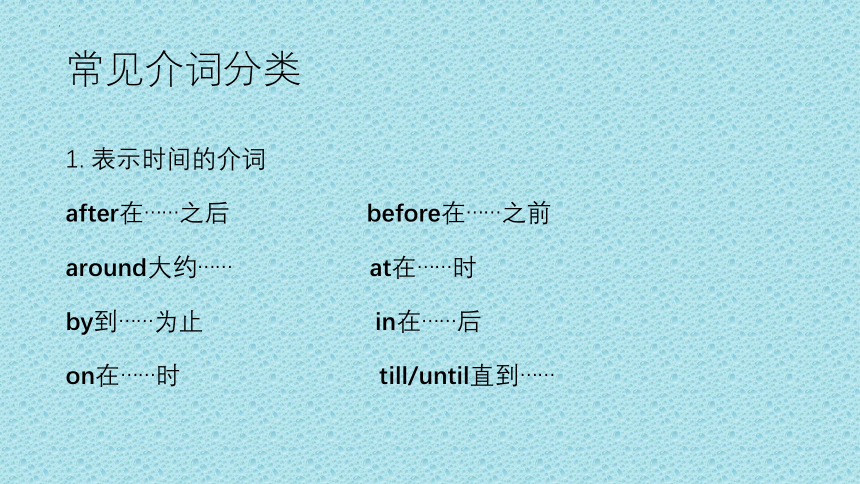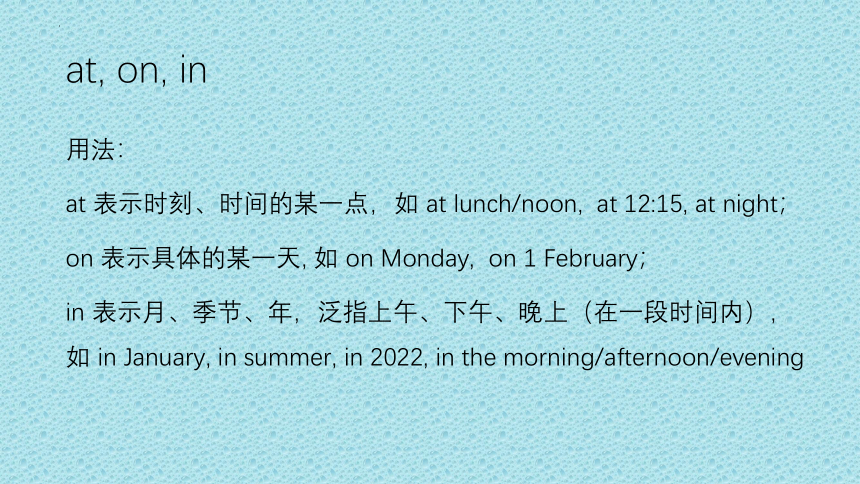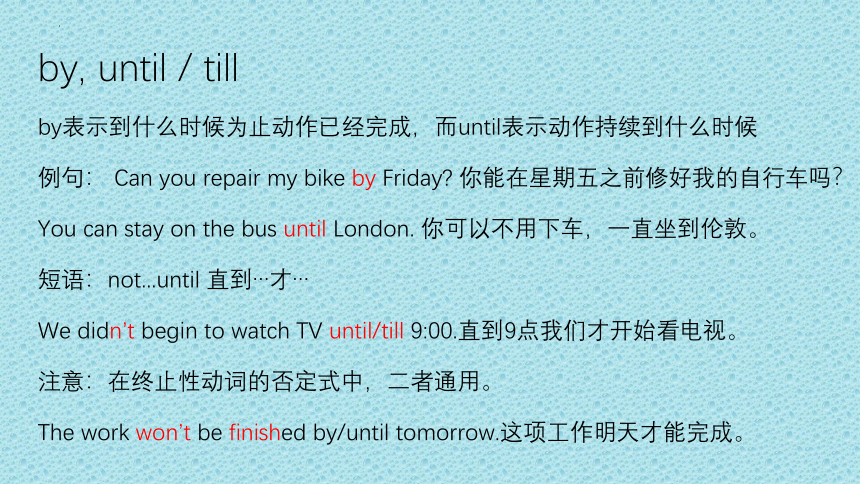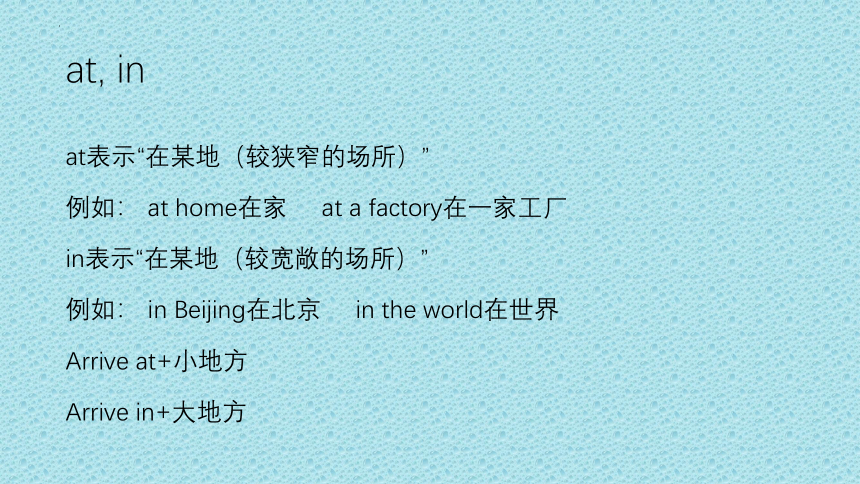2023届高考英语语法点梳理专题3:介词和连词课件(27张)
文档属性
| 名称 | 2023届高考英语语法点梳理专题3:介词和连词课件(27张) |  | |
| 格式 | zip | ||
| 文件大小 | 133.9KB | ||
| 资源类型 | 教案 | ||
| 版本资源 | 通用版 | ||
| 科目 | 英语 | ||
| 更新时间 | 2022-07-27 17:54:35 | ||
图片预览









文档简介
(共27张PPT)
3 介词 Preposition
常见介词分类
1. 表示时间的介词
after在……之后 before在……之前
around大约…… at在……时
by到……为止 in在……后
on在……时 till/until直到……
at, on, in
用法:
at 表示时刻、时间的某一点,如 at lunch/noon, at 12:15, at night;
on 表示具体的某一天, 如 on Monday, on 1 February;
in 表示月、季节、年,泛指上午、下午、晚上(在一段时间内),如 in January, in summer, in 2022, in the morning/afternoon/evening
by, until / till
by表示到什么时候为止动作已经完成,而until表示动作持续到什么时候
例句: Can you repair my bike by Friday 你能在星期五之前修好我的自行车吗?
You can stay on the bus until London. 你可以不用下车,一直坐到伦敦。
短语:not...until 直到…才…
We didn’t begin to watch TV until/till 9:00.直到9点我们才开始看电视。
注意:在终止性动词的否定式中,二者通用。
The work won’t be finished by/until tomorrow.这项工作明天才能完成。
for, during, thorough
for表示“达……之久”,指经过多长时间,常和完成时连用
例句: They have lived here for five years. 他们已经在这里生活了5年。
during表示“在……期间或某项活动中”
例句:She learned Japanese during her stay in Shanghai.
她在上海逗留期间学会了日语。
through表示“一直……”,指从开始到结束。
例句: They played cards through the night. 他们打了一整夜的牌。
from, since
from表示“从……起”,from…to… 表示一段时间
例句: The meeting will be held from eight to ten.
这个会议将从8点开到10点。
since表示“自从……以来(表示从以前某时一直到现在仍在继续)”。
例句:I have been sick since yesterday. 我从昨天起就病了。(到现在还病着)
in, within
in 表示“在……后(未来时间)”
例句: He will be back in five hours. 他5小时后回来。
within 表示“不超过……的范围”。
例句: You must finish the test within an hour. 你必须在一小时之内完成这项测试。
2. 表示场所、方向的介词
across在……对面 along沿着……
at在…… in在……里
on在……上 above在……上方
under/below在……下面 beside在……旁边
behind在……后面 before/in front of在……前面
between在……之间 among在……之间
at, in
at表示“在某地(较狭窄的场所)”
例如: at home在家 at a factory在一家工厂
in表示“在某地(较宽敞的场所)”
例如: in Beijing在北京 in the world在世界
Arrive at+小地方
Arrive in+大地方
On, above, over, under, below
on表示“在……上面(有接触面)”, 如: on the tree 在树上
above表示“在……上方”- below表示“在……下方” ,如:
above the clouds在云端 below the surface of the water在水面下
over表示“在……正上方”- under表示“在……正下方”,如:
over the bridge 在桥上 under the chair 在椅子下
between, among, around
between表示“在两者之间”, 如 between A and B 在A和B之间;among表示“在三者(以上)之中”, 如 among the trees 在树林中
around表示“环绕(四周),在…周围”,如 around the school 在学校周围
in front of, behind, opposite
in front of表示“在……前面/正面”,如 in front of the classroom在教室前面
behind表示“在……后面”,如 behind my house在我家房子后面
opposite表示“在……对面”,如 opposite me 在我对面
along, across, pass, through
along表示“沿着” ,如 along the river 沿着河边
across表示“横穿(平面)”,如 across the river 横渡过河
past表示“经过” ,如 past the city hall 经过市政厅
through表示“通过(空间)” ,如 through the city穿过城市
to, for, from
to表示“到达……目的地或目标” ,如
get to the airport 到达机场
for表示“向……(目的地)”
leave for 动身去
翻译:我明天去上海。/我明天从北京去上海。
from表示“从……(地点)起”
from Beijing to Shanghai 从北京到上海
其他常用介词辨析
用法:
1..besides表示“除了……外,还有……”,表示累加关系,指包括介词宾语在内,如:
I like English and maths besides Chinese. 除了语文,我还喜欢英语和数学。
2. except表示“除……以外”,表示排除关系,指从整体中除去一部分;
but表示“除……以外”,与except同义,但是比except的语气更强烈。
例句:Everyone is here except Miss Ye. 除了叶老师外,所有人都在这里。
There is nothing in the basket but three eggs. 篮子里除了3个鸡蛋外,什么也没有。
介词短语
用法:介词和介词宾语一起构成介词短语,在句中可作表语、定语、状语、宾语补足语和插入语。
例句:
It is because of hard work. 那是因为辛苦工作的原因。
【介词短语作表语】
2. A gentleman in white went into the hall. 一个身着白衣的绅士走进大厅。
【介词短语作定语】
3. Don’t touch it with your hands. 别用手去摸它。
【介词短语作方式状语】
4. I found everything in good condition. 我发现一切正常。
【介词短语作宾语补足语】
5. In short, he is one of the most promising students I’ve ever known.
总之,他是我认识的最有希望的学生之一。
【介词短语作插入语】
Quiz
1.Mary was disappointed when she found out they had gone to the ball ____her.
except B. except for C. without D. besides
2. It's the third turning ____ the left after passing the post office
by B. in C. on D. for
3. The policeman helped the old woman____ the street.
through B. past C. across D. over
4. Early___ the morning of May, we started off____ the mountain village.
in;for B. in;to C. on;/ D. on; for
5. How many people are there____ your basketball team
A. on B. at C. among D. with
连词 conjunction
用法:并列连词用来连接平行对等、互不从属的词、短语或分句,可表示并列、转折、选择或因果等关系。
常见连词:
and表并列
or/or else 表选择
but表转折,不能和although/though连用
so表结果
for表原因
以下连词构成的短语作主语时,谓语动词选择要慎重!
either…or…意为“或……或……;不是……就是……” (就近原则)
例句:Either you or he is right. 不是你,就是他是对的。
2. neither...nor意为“既不……也不……” (就近原则)
例句: Neither he nor I speak a foreign language. 他和我都不会说外语。
3. not only...but also意为“不但……而且……” (就近原则)
例句:Not only the students but also the teacher was against the plan.
不但学生,而且老师也反对这个计划。
4. as well as…意为“又,不但……而且……”(就远原则)
例句:Mr.Lin as well as his parents joins in the party.
不但林先生的父母,而且林先生也参加宴会。
常用的从属连词
1. that 无词义,用于引导名词性从句(主语从句、表语从句、宾语从句、同位语从句)和定语从句。
例句:The trouble is that I’ve lost his address. 麻烦是我把他的地址丢了。【that引导的表语从句】
2. when,while和as意为“当……时”,用于引导时间状语从句,都可表示从句和主句的动作同时发生,when也可表示先后发生。
例句:When/While/As he was doing his homework, I came in.
当他写作业时我走了过来。
3. since意为“自从……以来”,引导时间状语从句。从句用一般过去时,主句多用一般现在时或现在完成时。
Many things have happened since I last saw him. 从我上次见到他以来发生了很多事。
How long is it since we last went to the theatre 我们多久没去看戏了?
4. as soon as意为“刚一……就”,引导时间状语从句。从句用一般现在时表示将来发生的动作或状态。
例句:I’ll tell Ann the good news as soon as she comes back.安一回来,我就告诉她这个好消息。
5. before意为“在……之前”,after意为“在……之后”,都可引导时间状语从句。
例句:Did she leave a message before she went 她走之前留言了吗?
I found her bag after she had left. 她走了以后,我发现了她的包。
6. till和until意为“直到……时”,可引导时间状语从句。一般认为till不如until正式,在书面语中不常用。句首通常用until。
例句:Can you wait till/until I come back 你能等到我回来吗?
He didn’t finish his homework until his mother came back.
直到他妈妈回来,他才完成作业。
7. because意为“因为”,引导原因状语从句。常用于回答why引导的特殊疑问句,不能和so连用。
例句:I did it because my mother told me to.
妈妈吩咐我去做这件事,我才做的。
8. if意为“如果”,引导条件状语从句(主将从现)
例句:If you need my help, I will come at once. 如果你需要我的帮助,我会马上过来。
9. though和although意为“虽然”,引导让步状语从句。它们都不能与but连用。
例句:Though I was tired, I still worked hard.
虽然我很累,但我仍然努力工作。
10. so...that意为“如此……以至于……”,引导结果状语从句。that后面跟的从句是否定句时,可与too...to互换。
例句:The box is so heavy that I can’t lift it.=The box is too heavy for me to lift. 箱子太沉了,我抬不起来。
提示:
1. though,although和as都可以表示“虽然”,引导让步状语从句。as引导的让步状语从句要用倒装语序,即把从句中的表语、状语或动词原形放在as之前。
例句:Try as she might, she couldn’t open the door. 她试过多次了,可仍然打不开那门。
翻译:他虽然年轻,但懂得很多。
2. though和although放在句首时用法相同,但如放在句末时用though,不用although,且前面有逗号。这几个词均不能与and,but连用,但可与yet连用。
例句:It tastes strange. It’s good, though.
Although (Though) she was busy with her work, yet she managed to find time to stay with her parents. 她虽然工作很忙,但她仍然花时间和父母相处。
3 介词 Preposition
常见介词分类
1. 表示时间的介词
after在……之后 before在……之前
around大约…… at在……时
by到……为止 in在……后
on在……时 till/until直到……
at, on, in
用法:
at 表示时刻、时间的某一点,如 at lunch/noon, at 12:15, at night;
on 表示具体的某一天, 如 on Monday, on 1 February;
in 表示月、季节、年,泛指上午、下午、晚上(在一段时间内),如 in January, in summer, in 2022, in the morning/afternoon/evening
by, until / till
by表示到什么时候为止动作已经完成,而until表示动作持续到什么时候
例句: Can you repair my bike by Friday 你能在星期五之前修好我的自行车吗?
You can stay on the bus until London. 你可以不用下车,一直坐到伦敦。
短语:not...until 直到…才…
We didn’t begin to watch TV until/till 9:00.直到9点我们才开始看电视。
注意:在终止性动词的否定式中,二者通用。
The work won’t be finished by/until tomorrow.这项工作明天才能完成。
for, during, thorough
for表示“达……之久”,指经过多长时间,常和完成时连用
例句: They have lived here for five years. 他们已经在这里生活了5年。
during表示“在……期间或某项活动中”
例句:She learned Japanese during her stay in Shanghai.
她在上海逗留期间学会了日语。
through表示“一直……”,指从开始到结束。
例句: They played cards through the night. 他们打了一整夜的牌。
from, since
from表示“从……起”,from…to… 表示一段时间
例句: The meeting will be held from eight to ten.
这个会议将从8点开到10点。
since表示“自从……以来(表示从以前某时一直到现在仍在继续)”。
例句:I have been sick since yesterday. 我从昨天起就病了。(到现在还病着)
in, within
in 表示“在……后(未来时间)”
例句: He will be back in five hours. 他5小时后回来。
within 表示“不超过……的范围”。
例句: You must finish the test within an hour. 你必须在一小时之内完成这项测试。
2. 表示场所、方向的介词
across在……对面 along沿着……
at在…… in在……里
on在……上 above在……上方
under/below在……下面 beside在……旁边
behind在……后面 before/in front of在……前面
between在……之间 among在……之间
at, in
at表示“在某地(较狭窄的场所)”
例如: at home在家 at a factory在一家工厂
in表示“在某地(较宽敞的场所)”
例如: in Beijing在北京 in the world在世界
Arrive at+小地方
Arrive in+大地方
On, above, over, under, below
on表示“在……上面(有接触面)”, 如: on the tree 在树上
above表示“在……上方”- below表示“在……下方” ,如:
above the clouds在云端 below the surface of the water在水面下
over表示“在……正上方”- under表示“在……正下方”,如:
over the bridge 在桥上 under the chair 在椅子下
between, among, around
between表示“在两者之间”, 如 between A and B 在A和B之间;among表示“在三者(以上)之中”, 如 among the trees 在树林中
around表示“环绕(四周),在…周围”,如 around the school 在学校周围
in front of, behind, opposite
in front of表示“在……前面/正面”,如 in front of the classroom在教室前面
behind表示“在……后面”,如 behind my house在我家房子后面
opposite表示“在……对面”,如 opposite me 在我对面
along, across, pass, through
along表示“沿着” ,如 along the river 沿着河边
across表示“横穿(平面)”,如 across the river 横渡过河
past表示“经过” ,如 past the city hall 经过市政厅
through表示“通过(空间)” ,如 through the city穿过城市
to, for, from
to表示“到达……目的地或目标” ,如
get to the airport 到达机场
for表示“向……(目的地)”
leave for 动身去
翻译:我明天去上海。/我明天从北京去上海。
from表示“从……(地点)起”
from Beijing to Shanghai 从北京到上海
其他常用介词辨析
用法:
1..besides表示“除了……外,还有……”,表示累加关系,指包括介词宾语在内,如:
I like English and maths besides Chinese. 除了语文,我还喜欢英语和数学。
2. except表示“除……以外”,表示排除关系,指从整体中除去一部分;
but表示“除……以外”,与except同义,但是比except的语气更强烈。
例句:Everyone is here except Miss Ye. 除了叶老师外,所有人都在这里。
There is nothing in the basket but three eggs. 篮子里除了3个鸡蛋外,什么也没有。
介词短语
用法:介词和介词宾语一起构成介词短语,在句中可作表语、定语、状语、宾语补足语和插入语。
例句:
It is because of hard work. 那是因为辛苦工作的原因。
【介词短语作表语】
2. A gentleman in white went into the hall. 一个身着白衣的绅士走进大厅。
【介词短语作定语】
3. Don’t touch it with your hands. 别用手去摸它。
【介词短语作方式状语】
4. I found everything in good condition. 我发现一切正常。
【介词短语作宾语补足语】
5. In short, he is one of the most promising students I’ve ever known.
总之,他是我认识的最有希望的学生之一。
【介词短语作插入语】
Quiz
1.Mary was disappointed when she found out they had gone to the ball ____her.
except B. except for C. without D. besides
2. It's the third turning ____ the left after passing the post office
by B. in C. on D. for
3. The policeman helped the old woman____ the street.
through B. past C. across D. over
4. Early___ the morning of May, we started off____ the mountain village.
in;for B. in;to C. on;/ D. on; for
5. How many people are there____ your basketball team
A. on B. at C. among D. with
连词 conjunction
用法:并列连词用来连接平行对等、互不从属的词、短语或分句,可表示并列、转折、选择或因果等关系。
常见连词:
and表并列
or/or else 表选择
but表转折,不能和although/though连用
so表结果
for表原因
以下连词构成的短语作主语时,谓语动词选择要慎重!
either…or…意为“或……或……;不是……就是……” (就近原则)
例句:Either you or he is right. 不是你,就是他是对的。
2. neither...nor意为“既不……也不……” (就近原则)
例句: Neither he nor I speak a foreign language. 他和我都不会说外语。
3. not only...but also意为“不但……而且……” (就近原则)
例句:Not only the students but also the teacher was against the plan.
不但学生,而且老师也反对这个计划。
4. as well as…意为“又,不但……而且……”(就远原则)
例句:Mr.Lin as well as his parents joins in the party.
不但林先生的父母,而且林先生也参加宴会。
常用的从属连词
1. that 无词义,用于引导名词性从句(主语从句、表语从句、宾语从句、同位语从句)和定语从句。
例句:The trouble is that I’ve lost his address. 麻烦是我把他的地址丢了。【that引导的表语从句】
2. when,while和as意为“当……时”,用于引导时间状语从句,都可表示从句和主句的动作同时发生,when也可表示先后发生。
例句:When/While/As he was doing his homework, I came in.
当他写作业时我走了过来。
3. since意为“自从……以来”,引导时间状语从句。从句用一般过去时,主句多用一般现在时或现在完成时。
Many things have happened since I last saw him. 从我上次见到他以来发生了很多事。
How long is it since we last went to the theatre 我们多久没去看戏了?
4. as soon as意为“刚一……就”,引导时间状语从句。从句用一般现在时表示将来发生的动作或状态。
例句:I’ll tell Ann the good news as soon as she comes back.安一回来,我就告诉她这个好消息。
5. before意为“在……之前”,after意为“在……之后”,都可引导时间状语从句。
例句:Did she leave a message before she went 她走之前留言了吗?
I found her bag after she had left. 她走了以后,我发现了她的包。
6. till和until意为“直到……时”,可引导时间状语从句。一般认为till不如until正式,在书面语中不常用。句首通常用until。
例句:Can you wait till/until I come back 你能等到我回来吗?
He didn’t finish his homework until his mother came back.
直到他妈妈回来,他才完成作业。
7. because意为“因为”,引导原因状语从句。常用于回答why引导的特殊疑问句,不能和so连用。
例句:I did it because my mother told me to.
妈妈吩咐我去做这件事,我才做的。
8. if意为“如果”,引导条件状语从句(主将从现)
例句:If you need my help, I will come at once. 如果你需要我的帮助,我会马上过来。
9. though和although意为“虽然”,引导让步状语从句。它们都不能与but连用。
例句:Though I was tired, I still worked hard.
虽然我很累,但我仍然努力工作。
10. so...that意为“如此……以至于……”,引导结果状语从句。that后面跟的从句是否定句时,可与too...to互换。
例句:The box is so heavy that I can’t lift it.=The box is too heavy for me to lift. 箱子太沉了,我抬不起来。
提示:
1. though,although和as都可以表示“虽然”,引导让步状语从句。as引导的让步状语从句要用倒装语序,即把从句中的表语、状语或动词原形放在as之前。
例句:Try as she might, she couldn’t open the door. 她试过多次了,可仍然打不开那门。
翻译:他虽然年轻,但懂得很多。
2. though和although放在句首时用法相同,但如放在句末时用though,不用although,且前面有逗号。这几个词均不能与and,but连用,但可与yet连用。
例句:It tastes strange. It’s good, though.
Although (Though) she was busy with her work, yet she managed to find time to stay with her parents. 她虽然工作很忙,但她仍然花时间和父母相处。
